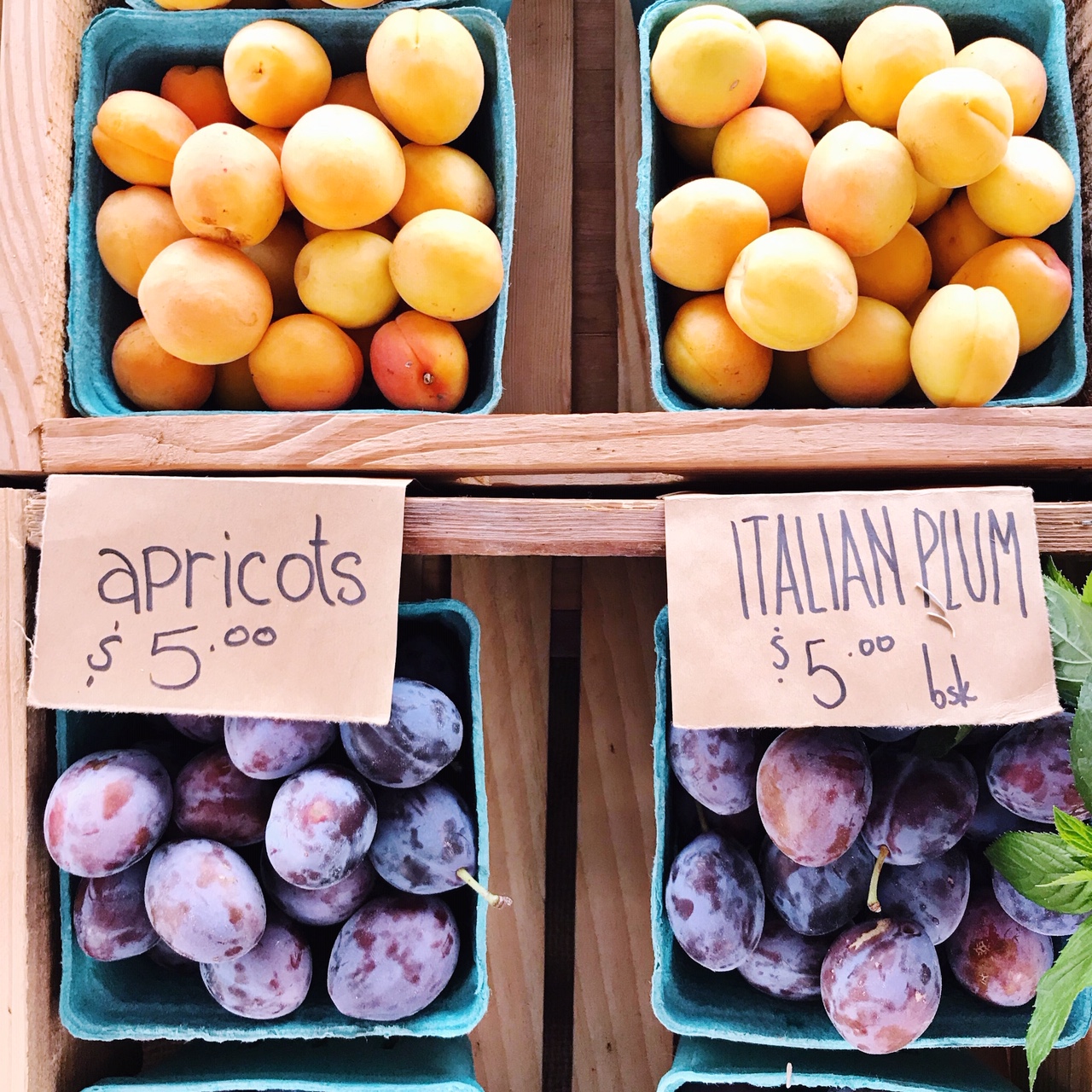If you are wondering which fruits and vegetables can freeze, and what the best way is to freeze them, this is your guide! I’ve also given some suggestions for my favourite way to use them so you can help eliminate food waste in your home.
Now more than ever, we are all trying to make the most out of what we have. While most fruits and veggies can be frozen (yay!), not all can, and some should be cooked or prepped first. Here is a guide to help you be as efficient as you can with your fresh produce!

Freezing Fruits and Vegetables
You can freeze most fruits and vegetables for future use which can be a huge help in preventing food waste! The best way to freeze most is to first remove any inedible peels (ie: banana peels), and evenly distribute the food on a baking sheet until frozen. Once frozen you can transfer the frozen fruit or vegetables into large resealable bags or into clear airtight containers. Write the date on the container (or a label) indicating when it was frozen so you know what to use first!

How to Avoid Freezer Burn
Freezing stops the reproduction of bacteria, so assuming your produce is good enough to eat when you are freezing it, you can easily freeze them to extend the life of your fruits and vegetables. What you do have to think about, is freezer burn, which happens when too much air gets in contact with your frozen food.
To avoid freezer burn, remove as much air from the container as you can and seal foods as well as possible (any air can dehydrate the food, which is what causes the freezer burn). Of course, practice FIFO (first in first out) with your frozen food so that nothing sits at the back of your freezer for too long! If you do have something that is freezer burnt, you can, should you wish, cut off that section of the food before using it.
How (and why) to Blanch Vegetables
Some vegetables are better if blanched before freezing. Blanching vegetables helps them last longer and improves the quality by stopping the enzymatic activity that causes vegetables to go bad. To blanch your vegetables simply immerse them in boiling water for 1-2 minutes and immediately plunge them in an ice bath to cool. To freeze simply drain the vegetables and place them on a large baking sheet – transfer them to a resealable container once frozen.

A-Z Fruit & Veggie Freezer Guide
Typically speaking, the higher the water content, the more shape the veggie or fruit will lose when it is thawed. Here are my freezing tips for commonly used fruits and vegetables:
- Apples – you can either grate them and freeze them in an air tight bag or turn them into an apple sauce before freezing in individual containers for baking (try these Apple Cinnamon Muffins), stirred into oatmeal or just as a healthy snack on its own.
- Avocados – if you have avocados that are about to turn you can simply peel then dice them, freeze on a baking sheet and store in the freezer to use in smoothies like these Green Smoothies.
- Bananas – freeze bananas by peeling them and placing them on a baking sheet before storing them in an air tight container. I will admit that I have frozen many bananas in their peel and just squeeze out the banana once thawed for use in banana bread or a banana cake (you may want to drain most of the liquid that comes out). Try these Banana Bread Sheetpan Pancakes or this decadent Banana Bread Breakfast Cake. You can alternately chop them first which makes them even easier to add to smoothies!
- Bell Peppers– frozen seeded and chopped bell peppers make a great addition to sauces, pastas, and soups. Since they are high in water you will want to cook with them after they are frozen as they break down, making them too soft to enjoy otherwise. Try this Roasted Red Pepper Pasta with Grilled Chicken or our signature Red Pepper Sauce.
- Berries – frozen berries are easy to add into pancakes, waffles, or baking recipes. If that’s not your jam then they’re amazing in smoothies! Our family also loves eating them from frozen.
- Broccoli – frozen broccoli is great to pull out of the freezer and steam, or use it to make this Potato Broccoli Soup. Just cut the broccoli into florets and blanch for 1-2 minutes before freezing on a baking sheet.
- Carrots – whether you slice them or dice them, carrots can be used in so many cooked recipes such as chili, soups, or stews. Grated carrots can be used in our many “Sneaky Mommy” recipes, including our Sneaky Mommy Spaghetti, Sneaky Mommy Hamburger Helper, and Sneaky Mommy Sloppy Joes.
- Cauliflower – similar to broccoli, cauliflower is great to have on hand to pull out of the freezer, steam, and serve as a side dish. You can also add it to smoothies! Frozen cauliflower (just cut it into chunks and blanch before freezing) can also be placed on a pan and roasted with olive oil, salt and pepper and then pureed into soups or mashed potatoes (try the ones from the cookbook – sooo good!).
- Cherries – cherries are so awesome to have in the freezer for a variety of recipes! You’ll want to pit your cherries before freezing. Spread them out on a baking sheet to freeze then place in a ziplock bag in the freezer.
- Celery – as with carrots, sliced celery is great to use in soups! It holds a little bit of extra moisture so it’s best used in broth-based soups like this Chicken Noodle Soup.
- Grapes – I freeze grapes whole and love them as a snack… especially in the summertime! Frozen grapes can also be added to your smoothies.
- Herbs – my grandma always used to take fresh dill and just chop it up and freeze it in a small container to use when she needed it in her Ukrainian recipes! For some other herbs like basil, try chopping it up and mixing it with some olive oil before freezing into ice cube trays to make it easy to add to soups and pastas in a pinch.
- Kale – we love a good green smoothie in our house and having frozen kale on hand makes life so much easier! Simply wash and dry your kale and tear into smaller pieces before freezing on a baking sheet. I store mine in a resealable bag or make smoothie packs with kale and other frozen fruits and veggies. You can also add frozen kale to soups or pasta dishes for some extra greens.
- Kiwi – just peel the kiwi and freeze it (cut into chunks if desired) for a quick addition to a smoothie. Note that it will get mushy after freezing.
- Lemons or Limes – You can freeze them whole but they will get mushy when you thaw them (fine if you just want the juice). Alternately you can squeeze the juice and freeze it in ice cube trays and zest and freeze the zest separately for use in baking – like this Raspberry Lemon Baked French Toast or these Lemon Blueberry Overnight Oats.
- Lettuce – Just don’t (too much water). Same thing with cucumbers or other water-packed veggies.
- Mushrooms – Clean then slice your mushrooms before freezing to make them easier to use in dishes like Mushroom Stew once thawed. Alternately you can blanch mushrooms in boiling water, which may extend their life. Mushrooms are very high in water so they will lose their texture once frozen but still make great additions to cooked dishes.
- Onions – You can simply chop up onions (any kind) and place them in an airtight container. Note that they will lose their shape and some texture once thawed so you will want to use them in cooking (not in recipes that require them to be raw).
- Oranges – Simply peel them then cut them up or keep in segments and freeze on a baking sheet to use in smoothies like these Golden Glow Smoothies.
- Peaches, apricots or plums – With these stone fruits simply remove the pits, cut into wedges and freeze on a baking sheet. Make this Peach Breakfast Crisp or add into smoothies (mmmm Peach Cobbler Smoothies).
- Pineapple – Simply cut off the skin and ends, remove the core, and cut it up and freeze it on a baking sheet. What a perfect addition to a smoothie or baking!
- Potatoes – Waxy potatoes like yellow potatoes, or even red potatoes, freeze best (uncooked or raw). However, mashed potatoes tend to freeze well in case you have other varieties on hand! Make and freeze dishes like this Shepherd’s Pie.
- Spinach – when it comes to spinach you can either freeze it raw, or you can sauté it or blanch it to freeze. Raw spinach is great to add to smoothies or soups, and cooked spinach is used in these delicious Spanakopita Rollups. You will want to squeeze as much water out of the spinach once it is cooked (just until it wilts then rinse under cold water) – freeze in an airtight container.
- Squash – Winter squash varieties such as butternut, acorn or buttercup freeze so well. Just peel them, remove the seeds and cut them into ~1″ chunks to be used in soups like this Butternut Squash Soup, Butternut Squash Gnocchi (sooo good) or a stellar twist on lasagne like this Butternut Squash Lasagna! Or if a sheetpan dinner is more your style check out this Butternut Squash Baked Chicken. I clearly have a thing for butternut squash but you can sub acorn or buttercup squash for these too.
- Sweet Potatoes – Peel, cube and blanch sweet potatoes for 2-3 minutes before freezing on a baking sheet. You can also freeze cooked mashed sweet potatoes. Try adding your frozen sweet potatoes to something fun like these Sweet Potato Pie Smoothies.
- Tomatoes – You can freeze whole or diced tomatoes for making pasta sauce, pizza sauce, or I roast them for Tomato Soup! This goes for any size of tomato… and honestly, you don’t even have to cut them up! If I buy a package of cherry tomatoes I will just wash them and throw them in the freezer in their package and make a roasted soup or roast them for pasta sauces (from frozen at 400 F with a drizzle of oil, salt and pepper ’til blistered).
- Zucchini – frozen zucchini is amazing in baking, check out this post for everything Zucchini related – like these incredible Zucchini Muffins. When it comes to freezing zucchini it’s best to grate it first if using it in baking, just be sure to squeeze out all the excess moisture when ready to use. Try adding them to these savoury Zucchini Bread Sheetpan Pancakes.
Note that a lot of leftovers also freeze well! Extra pasta sauce, smoothies (pour them into a popsicle mould for a fun and healthy treat), soups and casseroles all freeze super well and make for a convenient ‘fast food’ when you’re looking for a quick lunch.

